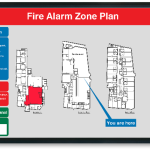When was the last time carried out a fire risk assessment? How about fire safety training – do your employees know what to do in the event of a fire?
The law doesn’t state how often you should carry out fire risk assessments in your business. However it does state that the person responsible for fire safety within your company must review assessments ‘regularly’ to ensure they’re up to date. The Regulatory Reform (Fire Safety) Order 2005 (commonly known simply as the Fire Safety Order) introduced a legal duty for ‘the responsible person’ to take all reasonable steps to ensure that fire safety levels are appropriate at all times.
Fire risk assessments must be reviewed if:
- there’s reason to think it’s no longer valid (for example, if there has been a fire in the shared parts of the building)
- there have been significant changes since the assessment was done (for example, major building works or more people using the building)
To make life easier, many fire risk assessments contain a recommended review date in order for you to stay on top of your legal responsibilities.
As a business owner, it’s your moral responsibility to ensure that anyone and everyone on your premises can escape safely. It also happens to be the law too, and there are severe penalties for those who fail to comply.
Should a fire break out within your business, your first priority is to quickly and safely evacuate your staff from the premises. However, you can never guarantee that everyone will be aware of your evacuation procedures. Similarly, in the event of an emergency people may forget your fire safety procedures. That’s why it’s so important to have a regular programme of fire safety management in place.
Broken down, fire risk assessments provide a snapshot of the level of protection your property achieves when ensuring the safety of anyone on site in the event of a fire. Fire risk assessments also identify corrective actions and any further steps that may be needed to achieve an appropriate level of fire safety.
What Must You Do As A Business Owner?
- Ensure your premises has an up to date fire risk assessment completed by a competent person
- Review your fire risk assessments regularly
- Ensure an emergency plan is present and communicated to your team so that you know what to do if a fire does occur in your premises.
- Undertake frequent fire drills to ensure that everyone knows their role and responsibility should a fire occur
- Maintain and regularly test any fire protection equipment such as fire extinguishers, alarms and any other measures
- Induct and train all employees in fire safety when they start work. Refresh the training periodically
- Nominate fire marshals and ensure they have appropriate training
How To Carry Out A Fire Risk Assessment
If your business or organisation is relatively small and you think your potential risks aren’t complex, it is possible carry out an assessment yourself. Keep in mind that the government recommends companies use third party certified companies for the fire safety management and advises against carrying them out yourself. However, if you think you have the knowledge and capability to carry out the assessment yourself, here is what you need to do:
Step 1: Identify hazards, i.e. anything that may cause harm.
Employers have a duty to assess the health and safety risks faced by their workers. Employers must systematically check for possible physical, mental, chemical and biological hazards.
Step 2: Decide who may be harmed, and how.
Identifying who is at risk starts with your organisation’s own full- and part-time employees. Employers must also assess risks faced by agency and contract staff, visitors, clients and other members of the public on their premises.
Step 3: Assess the risks and take action.
This means employers must consider how likely it is that each hazard could cause harm. This will determine whether or not your employer should reduce the level of risk. Even after all precautions have been taken, some risk usually remains. Employers must decide for each remaining hazard whether the risk remains high, medium or low.
Step 4: Make a record of the findings.
Employers with five or more staff are required to record in writing the main findings of the risk assessment. This record should include details of any hazards noted in the risk assessment, and action taken to reduce or eliminate risk.
Step 5: Review the risk assessment.
Ensure that agreed safe working practices continue to be applied (e.g. that management’s safety instructions are respected by supervisors and line managers)
Fire Safety Training
Every business has unique risks and requires different levels of fire safety management. There is no one size fits all approach to fire safety management, and that’s where ELAS really excels.
ELAS believes in going the extra step to provide the best possible service to its clients. The company also believes that training should be fun – in the event of a fire, your staff are more likely to recall their training if they have enjoyed it! While other companies might use some burning petrol in a tray for their fire training, ELAS has developed specialist fire simulation equipment which can simulate Class A (paper, wood etc.), Class B (burning liquids) and Class C (gas) fires.
Participants on the company’s fire training courses get to really work at putting out a fire in a meaningful way. Learning the skills needed in a safe and controlled environment provides your employees with hands on practical experience that really benefits your business.
The government recommends that businesses use third party certified providers for their fire safety. ELAS is a BAFE approved organisation meaning it has been audited and certificated to ensure quality and competence when it comes to fire safety. ELAS don’t just provide you with a templated document to complete yourself. The company’s fire safety consultants will visit your premises and complete your fire risk assessment for your business. As well as conducting a fire risk assessment, you will also need to have a comprehensive fire safety policy that details the procedures you have put in place to reduce the risk of fire, and promote fire safety within your business.





